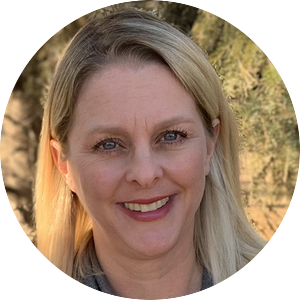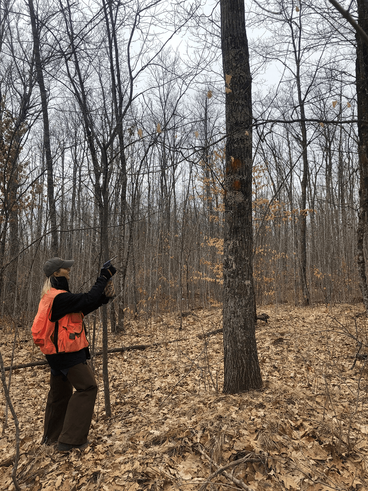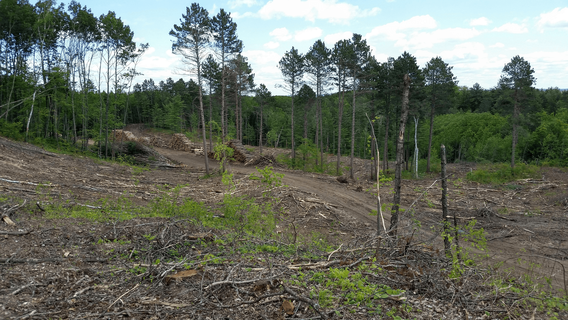Amy Rand (M.S. Forestry, 1995) came to forestry like many of us do, by spending a lot of time outside as a kid. She was born in Ely and lived, as she describes it, “out in the middle of nowhere near Bear Island Lake” until she was 7 before moving to Knife River on Lake Superior’s North Shore. Her father worked in the U.S. Forest Service as a planner for the Superior National Forest, but he didn’t talk about it much. Her interest in the woods came from poking around outside.
“I brought mosquito larvae to show-and-tell. I don’t think my teacher was all that impressed, but I thought it was cool.”
Amy says she didn’t know much about forestry then but knew she liked being outdoors and wanted to find a way to continue doing it somehow. That journey started with a Bachelor’s degree in Biology from St. Olaf College. “You get the degree and figure the rest of it out on the back end. When I graduated, I wondered what am I going to do with this B.A. in biology, so I went to get my masters because what else was I going to do.”
Coming from a rural small town can be intimidating, and Amy was hesitant at first but after visiting the St. Paul campus, she found it felt like the small, private college environment she was accustomed to at St. Olaf. She didn’t shy away from the hustle and bustle of the city altogether, though. “My grad school years at the university while living in Uptown were probably some of my favorite times. I loved living in Uptown and all the culture there. I was four blocks from the lake, and I would rollerblade or walk around it every day.”
She came to the University of Minnesota expecting to study fish and water, but she found a research assistantship with Jim Perry and enrolled in the Master’s Degree program for Forestry. Amy was surprised by how little time she ended up spending in the classroom, which was fine with her. “Jim gave me a lot of leeway to sink or swim, and I liked that. He said I could study whatever I wanted for my thesis, but it had to have something to do with forestry, so I studied large woody debris accumulations in the Lower St. Croix National Scenic Riverway and fish taxa association. I ended up doing all my research work in the field on the Lower St. Croix, driving 100 miles every day in the summer. I had an undergraduate assistant from Wellesley College to record data for me while I was snorkeling in the river near the debris locations. I would go under for about 2 minutes at a time, then come up and tell her what species of fish I observed and what they were doing. One time I came face-to-face with this huge catfish, and we both freaked out and went in opposite directions.” Her customized research gave her a nuanced understanding of the water impacts of forestry. “What you do on the land adjacent to water affects all kinds of things in the water. If you remove trees from the landscape, you’re going to affect storm flow and shading. The St. Croix needed trees to fall into the water and pile up so the young fish would have some shelter.”
Every student faces the same inevitable question at the culmination of their studies, and Amy was no different. “I had a Master’s degree in forestry, but it was really in animal behavior and water, and oh, yeah, what am I going to do for a living?” Her mother saw a forestry position in Cass county advertised in the Duluth newspaper and sent it to her. Amy applied for the job, but they weren’t ready for her until the winter, so they referred her to the land commissioner in Crow Wing county to fill a temporary summer position. They hired me in Crow Wing for four months and trained me. I’m sure I received a lot more help than I gave.” She joined the Cass County Land Department as a Forest Resource Manager that winter, and she’s been there for over 20 years.
“We plan timber sales and lay it out on digital maps with aerial photography. One person will use GPS and paint the perimeter boundary, and the other person will cruise the timber volume and take plots with a prism. When a logger buys it, we’ll administer the timber sale to make sure they’re cutting the right things. Then we update that area’s inventory afterwards using digital models and ArcGIS. When I first started, there was no GPS, no ArcGIS, and no email, so we had to do everything on paper and send it back and forth.”
There were very few women working in forestry at the county level when she started, and that number has ebbed and flowed over the years. “When I first started, it was very weird for the loggers. Now there are women foresters everywhere in the DNR. After I got my own management area, they’d still ask for my mentor, Jerry, and he’d tell them to go talk to me. As a 25-year-old woman with very little forestry experience, how do you tell a 45-year-old man who’s been logging for years what you think he should be doing? Loggers definitely know if you’re green behind the ears. Now that I’ve known these guys for 20+ years, we’ve formed relationships, and that was definitely an important skill. There are a lot of personalities to manage, and communications skills, both written and verbal, are huge.”
Working at the county level affords Amy a tremendous amount of autonomy and the opportunity to connect with her land and the people who use it. Managing the same area for over 20 years allows her to see the outcomes of management decisions she made years earlier. “If I was going to be a forester anywhere, I’d pick a county in Minnesota. You have a lot of freedom to make decisions. If you want to stay in touch with the woods and not be at a desk and managing people, this is the job.”
Forest management isn’t glamorous work, but it has a satisfying mix of variety and stability. “It’s people management as much as it is land management. We deal with everything from driveway easements, recreational trails, and somebody driving by your timber sale who doesn’t like the way it looks because you cut down a bunch of trees.” Public engagement and education is an important and sometimes underappreciated element of forest and natural resources management. It can be hard for people living in metropolitan areas to access forests at scale, so we develop emotional attachments to the individual trees in our front yards or on our streets. It feels like a loss when one of them gets cut down, and seeing a timber sale looks and feels like thousands of individual trees being lost.
“I’ve always argued that foresters are really bad at explaining what we do and why we do it. The public sees what we do, and it’s ugly. A timber sale is not appealing to look at, but I tell people it’s like appendix surgery. You look perfectly fine to the untrained eye, but you’re gonna die if you don’t get the operation. If you walked in when the surgeon was doing the surgery, it would be a bloody mess. There’s a scar afterwards, and it takes a while to heal, but you’re better off.”
Amy has seen tremendous growth and evolution in the forestry profession since she started, especially due to certification and accountability for planning and documentation. “It’s going to evolve even more with climate change and the attention from the big fires out west. People are going to start realizing that managing forests can prevent some of those huge fires.” The renewable economic value that properly managed forests can provide, in the form of wood and fiber products, is imperative to providing resources for a continually growing population. She thinks foresters need to assert the value of managing forests on public lands so those lands can remain forested as other economic pressures compete for space and use.
“People look at a forest and they think that’s the way it’s going to stay that way forever if no one touches it, but trees are not static on the landscape. Natural disasters happen. Fires happen. Wind storms happen. That’s the education responsibility foresters have. Foresters need to explain what, why, and how. You may not believe us or like what we have to say, but we have to give that information to the public. I tell people who look at timber sales, ‘what you think is a pristine forest was actually cut 100 years ago and this is the second rotation.’ Certain species, without management, will simply fall down and create brush in the absence of fire and the forest will degrade. Maybe that won’t happen in your lifespan, but it will in your children’s or grandchildren’s lifetimes. We need to have patience. We live a certain lifespan, but trees generally live a longer lifespan. We need to scale our personal time frames to the forest’s time frame. It’s definitely far more in control.”
Image 1 description: Amy Rand, a white woman with blond hair smiling in front of a wooded background.
Image 2 description: Amy Rand, a white woman in an orange work vest, measuring the height of a tree.
Image 3 description: A timber sale, a recently cut forest with stacked lumber.



